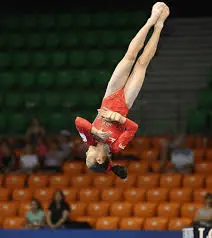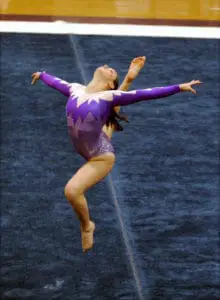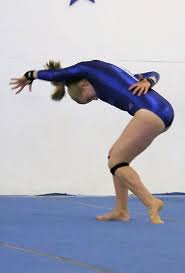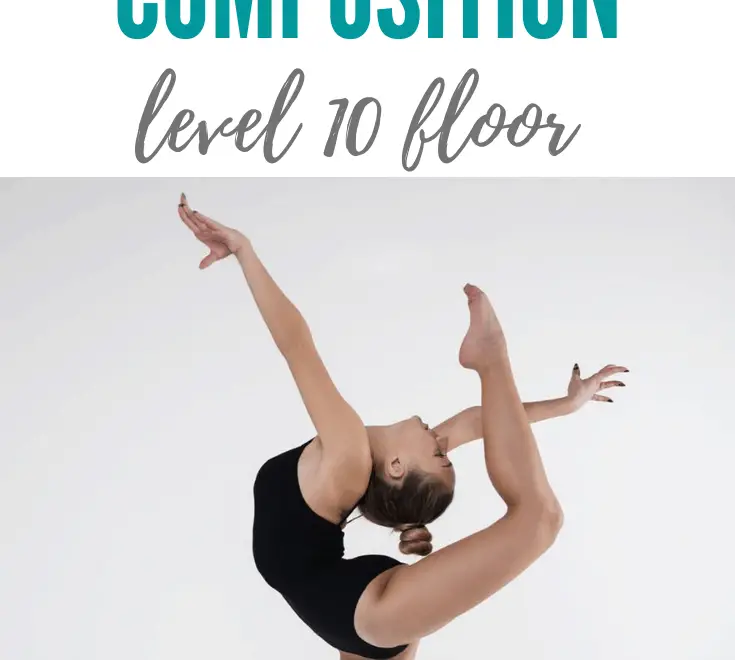This article has been updated to reflect the changes in the 2022-2026 DP Code of Points.
Have you ever watched a floor routine that looked amazing, but then it scored low? I know I have! Especially before I started judging, it just didn’t make sense! What was the problem? Composition deductions!
But what exactly does that mean? We’ll take a closer look today.
This is the third article in a three-part series. In case you missed the first two articles, you can read here about Level 8 and Level 9 composition deductions.
This series discusses composition deductions on floor for levels 8, 9, and 10. In 2018, USAG made changes to their compositional deductions, in order to make the “up to the level” deductions more specific. There are three categories of “Up to the Level” deductions: Acro, Dance, and Dismount. In this article, I will discuss these deductions in detail as they relate to Level 10 floor.
Value Parts in a Level 10 Floor Routine
When a coach and gymnast are constructing a routine, they will first want to consider the skills, or Value Parts, that are allowable for the gymnast’s level. For those who are unfamiliar, skills in the J.O. Program are valued from A to E, with A skills being the easiest, and E skills being the most difficult. Level 10 gymnasts are allowed to perform any elements, A through E, for both acro and dance skills. Level 10’s will want to fulfill their Special Requirements and compositional requirements using skills that showcase the gymnast’s strengths, meet the difficulty level to the best of the gymnast’s ability, and that minimize deductions.

Acro Composition Deductions in a Level 10 Floor Routine
The composition deductions for acro level are split into two categories: 3-pass routines and 2-pass routines. The deductions are different in the two categories, with more strict rules for 2-pass routines. If a gymnast does a 3-pass routine, and has a D in all three passes, or 2 D’s and a B+C bonus combination, she will receive no deduction. If she has no D saltos in any of her passes, she will get the maximum 0.20 deduction. For a 2-pass routine, she must perform E saltos in both passes, or an E and D+A direct connection, for no deduction. If she has no D/E saltos, or one D and a C+A or less difficult 2nd pass, she will receive the maximum 0.20 deduction. Here are some examples:
3-pass Routine
- Double pike (D)
2 1/2 twist, punch front (D+A +.20)
Rudi (D)
NO deduction - Full-in (E)
Double back (D)
1 1/2 twist, front layout (C+B +.20)
NO deduction - Arabian double front (E)
Front double full (E)
Front full, front tuck (C+A +0.10)
0.05 deduction - Double back (D)
Rudi (D)
Front tuck through to double full (A+C, no bonus)
0.10 deduction - Double pike (D)
1 1/2 twist, front layout (C+B +0.20)
Front-full, front tuck (C+A +0.10)
0.10 deduction - Rudi (D)
Front layout, front-full (B+C +0.20)
Double full (C)
0.15 deduction - Double back (D)
1 1/2 twist, front tuck (C+A +0.10)
Front pike through to front-full (B+C indirect, no bonus)
0.15 deduction - 1 1/2 twist, front layout (C+B +0.20)
Double full (C)
Front-full (C)
0.20 deduction
2 pass routine
- Double layout (E)
Front double full, front tuck (E+A)
NO deduction - Double front (E)
2 1/2 twist, front tuck (D+A)
NO deduction - Front tuck through to double back (A+D indirect, +0.10)
Rudi, layout stepout (D+A direct, +0.20)
0.05 deduction - Front double full (E)
Whip through to double pike (A+D indirect, +0.10)
0.05 deduction - Whip, 2 1/2 twist (A+D direct, +0.10)
Rudi (D)
0.10 deduction - Full-in (E)
Front-full, front tuck (C+A direct, +0.10)
0.10 deduction - Double layout (E)
Front-full, front pike (C+B +0.20)
0.10 deduction - Front double full (E)
1 1/2 twist, front-full (C+C +0.20)
0.10 deduction - Double back (D)
Front-full, front layout (C+B +0.20)
0.15 deduction - Rudi, layout stepout (D+A, +0.20)
Double full (C)
0.15 deduction - Full-in (E)
Front layout, front pike (B+B)
0.15 deduction - Double pike (D)
Front tuck through to 1 1/2 twist (A+C indirect, no CV)
0.20 deduction - Front-full, front layout (C+B)
1 1/2 twist, front pike (C+B)
0.20 deduction

Dance Composition Deductions
To receive no deduction for dance composition, the gymnast must perform 3 C elements OR 2 D/E elements, either in combination or isolated. She will receive the maximum deduction if she performs only 1 C element, or 2 B elements.
- Switch-side, Popa (C+C)
Double turn (C)
NO deduction - Cat leap, switch-full (A+D)
Tuck jump double (D)
NO deduction - Switch-ring, switch-1/2 (C+C)
1 1/2 turn (B)
0.05 deduction - Tour jete 1/2, tuck jump (C+A)
Ring jump 1/1 (D)
0.05 deduction - Split jump full, wolf jump full (C+C)
0.10 deduction - Switch leap, sissone (B+A)
Triple turn (D)
0.10 deduction - Cat leap 1 1/2 (C)
Split leap, side leap (A+B)
0.15 deduction - Split leap, cat leap 2/1 (A+D)
0.15 deduction - Double turn (C)
Split leap, jump 1/1 (A+A)
0.20 deduction - Switch leap, straddle jump (B+B)
0.20 deduction

Dismount Composition Deductions
To receive no deduction for dismount composition on floor, the gymnast must perform a D/E salto, or a C+B direct connection of two saltos. She will receive the maximum deduction if she performs an indirect A+C connection, or an isolated C salto or less difficult.
- D/E (Double back, Rudi, 2 1/2 twist, etc)
NO deduction - Front-full, front pike (C+B direct)
NO deduction - Front pike stepout through to 1 1/2 twist (B+C indirect)
0.05 deduction - 1 1/2 twist, front tuck (C+A direct)
0.05 deduction - Front tuck stepout through to double full (A+C indirect)
0.10 deduction - Isolated front-full (C) or less difficult
0.10 deduction
The one gray area with Level 10 dismount deductions is a B+B direct tumbling pass. This pass still receives bonus, so it could be considered a 0.05 deduction, similar to the C+A direct connection. However, neither skill is a minimum C value, so the full 0.10 deduction could also be considered.
Other Composition Deductions
- Lack of minimum “B” turn: 0.2. If the gymnast attempts a B turn but it is more than 90 degrees incomplete, or if she does not attempt one at all, she will receive this deduction. It doesn’t come off the start value, but instead is taken at the end of the routine.
- Lack of minimum of C salto: 0.3.
- Failure to perform saltos or aerials in two different directions: 0.1. The gymnast must perform a backward salto/aerial, and a forward or sideward salto/aerial. An Arabian salto is considered a forward salto. Aerial cartwheels or walkovers will fulfill this compositional requirement, even though they do not fulfill the salto Special Requirement.
- Overuse of dance elements with same shape: 0.1. This deduction would be taken only for more than two straddle jumps (with/without turn), or more than two elements with a wolf or tuck position (with/without turn).
- Insufficient use of floor exercise area: up to 0.1. This deduction could be applied if the gymnast stays in the same section of the floor mat for most of her routine.
As you can see, there are many different components of composition deductions for Level 10 floor. If you’re meeting all of these categories and are still unsure of the deductions, general deductions and specific execution are the next place to look. Put it all together and the result will be fantastic!
I love watching Level 10 floor because of the exciting skills and combinations you will see! Are there any of your favorites that I didn’t mention here?
Further Reading
The Ideal Composition for a Level 10 Bar Routine
Making Sense of Composition: Level 10 Beam
Making Sense of Composition: Level 8 Floor
Making Sense of Composition: Level 9 Floor
How to Demonstrate Artistry in Gymnastics
References
USA Gymnastics Development Program Code of Points, 2022-2026.
